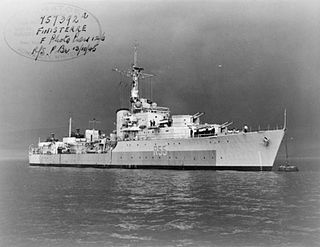
HMS Finisterre was a Battle-class destroyer of the Royal Navy (RN). She was named after one of the battles of Cape Finisterre. She was the first and thus far the only ship of the Royal Navy to bear this name.
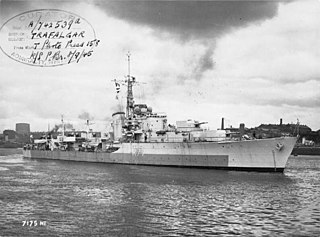
HMS Trafalgar was a Battle-class destroyer of the Royal Navy (RN). She was named after the Battle of Trafalgar, a decisive British victory over a Franco-Spanish Fleet in 1805. Trafalgar was built by Swan Hunter on the Tyne. She was launched on 12 January 1944 and commissioned on 23 July 1945.

HMS Dunkirk (D09) was a later or 1943 Battle-class fleet destroyer of the British Royal Navy (RN). Though there were other ships of the Navy that had been named Dunkirk, as far back as the 1650s, it held added meaning after the evacuation from Dunkirk between late May and early June 1940, in which over 300,000 British, as well as French troops, were rescued by a ragtag fleet of ships.
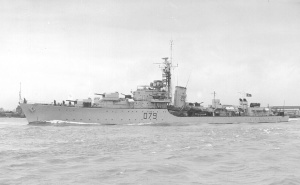
HMS Cadiz was a Battle-class destroyer of the Royal Navy. She was named after the Battle of Cádiz, in which the French besieged the Spanish town in 1810, which was eventually lifted in 1812 after the French defeat at the Battle of Salamanca.

HMS Barrosa (D68) was a later or 1943 Battle-class fleet destroyer of the Royal Navy.

HMS Aisne (D22) was a 1943 or later Battle-class fleet destroyer of the Royal Navy. She was named after one of the Battles of the Aisne.
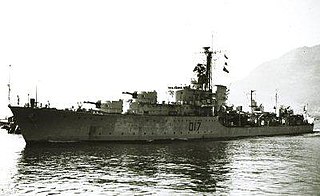
HMS Alamein (D17) was a Later or 1943 Battle-class fleet destroyer of the British Royal Navy. She was named in honour of the Battle of El Alamein, which took place in 1942 during the Second World War, between Commonwealth forces and the German Afrika Korps.

HMS Agincourt (D86) was a later or 1943 Battle-class fleet destroyer of the Royal Navy. She was named in honour of the Battle of Agincourt, fought in 1415 during the Hundred Years' War. Agincourt was built by R. & W. Hawthorn, Leslie & Company Limited on the River Tyne. She was launched on 29 January 1945 and commissioned on 25 June 1947.

HMS Corunna (D97) was a later or 1943 Battle-class fleet destroyer of the Royal Navy. She was named in honour of the Battle of Corunna, which took place during the Peninsular War in 1809 between British and French forces. Corunna was built by Swan Hunter & Wigham Richardson Limited on the Tyne. She was launched on 29 May 1945 and commissioned on 6 June 1947.

HMS St. Kitts was a Battle-class destroyer of the Royal Navy (RN). She was named in honour of the Battle of St. Kitts which took place in 1782. So far she has been the only ship of the Royal Navy to bear the name. St. Kitts was built by Swan Hunter & Wigham Richardson Limited on the Tyne. She was launched on 4 October 1944 and commissioned on 21 January 1946.
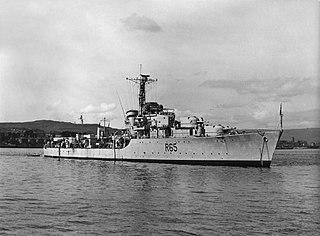
HMS St. James was a Battle-class destroyer of the Royal Navy. She was named in honour of the Battle of St. James Day which took place in 1666.

HMS Solebay was a Battle-class destroyer of the Royal Navy (RN). She was named after the Battle of Solebay which took place in 1672 between an Anglo-French force and the Dutch Navy during the Third Anglo-Dutch War. Solebay was built by R. & W. Hawthorn, Leslie & Company Limited on the Tyne. She was launched on 22 February 1944 and commissioned on 25 September 1945.

HMS Rocket was an R-class destroyer of the Royal Navy that saw service during Second World War. Built by Scotts Shipbuilding and Engineering Company in Greenock, Scotland, she was launched in October 1942 and commissioned in August 1943.

HMS Relentless was an R-class destroyer of the Royal Navy that saw service during World War II. She was later converted into a Type 15 fast anti-submarine frigate, with the new pennant number F185.
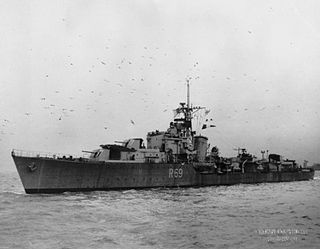
HMS Ulysses was a U-class destroyer of the British Royal Navy that saw service during World War II. She was later converted into a Type 15 fast anti-submarine frigate, with the new pennant number F17.
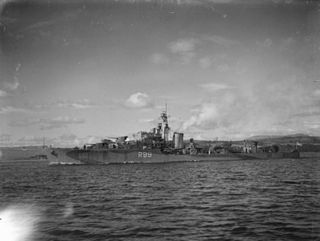
HMS Urchin was a U-class destroyer of the British Royal Navy that saw service during the Second World War.

HMS Venus was a V-class destroyer of the Royal Navy that saw service during the Second World War. She was built by Fairfield Shipbuilding and Engineering Company, of Govan, Scotland and launched on 23 February 1943.

HMS Virago was a V-class destroyer of the British Royal Navy that served in World War II. She was later converted into a Type 15 fast anti-submarine frigate, with the new pennant number F76.

HMS Wakeful was a W-class destroyer of the Royal Navy launched in 1943. She saw service during the Second World War and was later converted into a Type 15 fast anti-submarine frigate. She was sold for scrap in 1971.

HMS Tenacious was a T-class destroyer of the Royal Navy that saw service during the Second World War. She was built by Cammell Laird, of Birkenhead and launched on 24 March 1943.




















